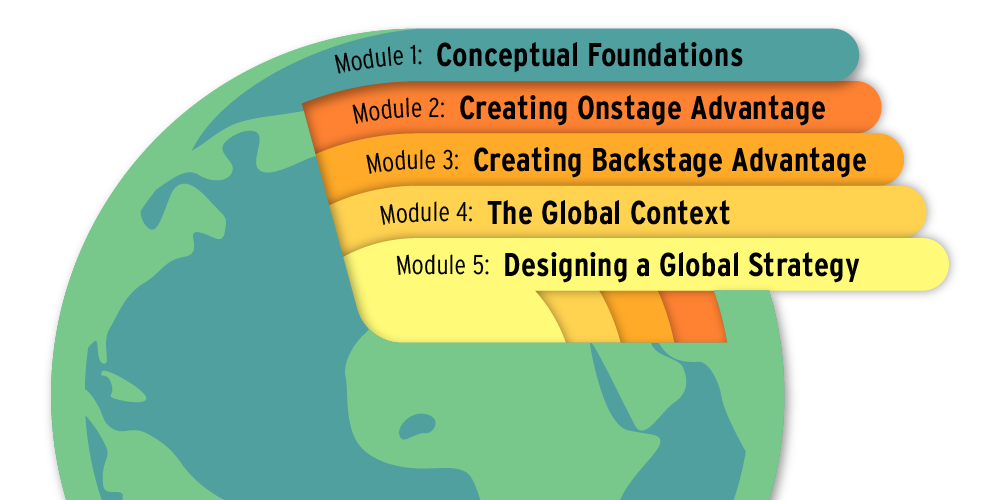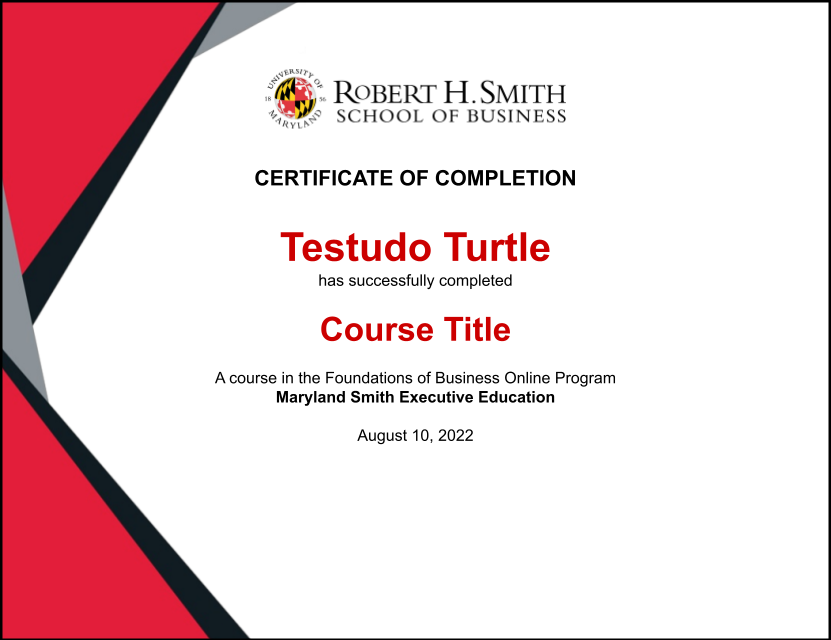Global Business Strategy
Foundations of Business Online Program
PROGRAM DETAILS
Start Dates: Enroll Immediately
Duration: 30 hours of content
Format: 100% Online
Tuition: $299
Program Description
This course on Global Business Strategy is divided into two parts, one which focuses on business strategy and one which focuses on global strategy. The core premise is that if there are serious weaknesses in a company's business strategy, then no degree of sophistication regarding global strategy can save the company. Thus, the design of a company's global strategy depends hugely on the key elements and soundness of its business strategy. The first part of this course, focusing on business strategy, aims to give you the tools, frameworks, and ideas necessary to develop business unit strategies for your own organization.
The second part of this course focuses on how to expand your business globally and succeed. A central idea here is that globalization is a double-edged sword. It can bring several benefits such as faster growth, a bigger scale, and the ability to serve global customers with distributed needs worldwide. On the other hand, globalization also exposes the firm to unfamiliar challenges, greater complexity, and higher fixed costs. Thus, unless the benefits exceed the costs, globalization will backfire.

Why take this course?
Some key topics we'll cover in this part of the course include: what differentiates a "globally integrated" from a "multi-domestic" industry and why it matters, how to build a strategy for global market expansion, and how to decide whether to go alone or partner, how to decide how much to adapt to local market peculiarities, how to globally optimize various activities in the business's value chain, how to groom local and global leaders, how to cultivate a global mindset.
By the end of this course, you will be able to:
- Assess your business strategy, including the fundamental sources of your competitive advantage.
- Explore and examine potential Blue Ocean opportunities within your industry.
- Assess the strength (or weakness) of your company’s competitive advantage along both dimensions: onstage (i.e., in the eyes of customers on criteria that matter to them) and backstage (i.e., in terms of your resources and capabilities).
- Develop a game plan to strengthen your company’s competitive advantages both onstage and backstage.
- Explain the global economic structure of your industry - especially whether the odds favor local players or global players, how much, and why.
- Develop a strategy for the globalization of your company's market presence.
- Design a strategy for the global optimization of your company's value chain.
Course Topics
In this module, we will discuss what we mean by the concept of "strategy." We'll look at how strategies at different levels of corporate aggregation are interlinked with each other. We'll unpack the concept of "business strategy." We'll examine what the term "competitive advantage" means. And we'll look at how to analyze the structure and dynamics of the industry eco-system in which the company is embedded.
This module will equip you to:
- Define strategy.
- Discuss the interlinkages between strategies at various levels of the organization: corporate strategy, business strategy, global strategy, functional strategy, and sub-function strategy.
- Identify key elements of business strategy.
- Describe competitive advantage.
- Differentiate between onstage competitive advantage and backstage competitive advantage.
- Analyze an industry’s structure of suppliers, customers, complementors, and competitors and locate the industry within the broader socio-economic-political-technological context.
This module is a closer examination of the principles we discovered in Module 1. Here, we are focusing on how they apply to onstage advantage.
This module will equip you to:
- Differentiate between “blue ocean” and “red ocean” opportunities.
- Describe the three types of “blue ocean” opportunities.
- Describe two factors used to determine the optimal scope of a business.
- Given a company, identify opportunities to create “onstage” competitive advantages.
In this module, we move from onstage advantage to backstage advantage. Backstage advantages refer to a business's competitive advantage (or lack thereof) in terms of the resources, capabilities, and relationships that are necessary to create and sustain the desired onstage advantages.
This module will equip you to:
- Determine the current basis for and future opportunities to create backstage advantages.
- Identify opportunities to transform the architecture of the value chain.
- Assess whether or not to outsource or internalize any activity.
- Assess the extent to which internal capabilities are being continuously upgraded.
- Assess the extent to which the company’s culture creates competitive advantage/disadvantage.
- Assess the extent to which the company's scale and scope create competitive advantage/disadvantage.
- Assess how the company’s relationships with external parties create competitive advantage/disadvantage.
- Identify the Alpha, Beta, and Gamma capabilities of the company and determine future strategic actions.
This module focuses on how to analyze the broader global context (especially as it pertains to the company's industry). The basic logic is that assessing or designing the company's global strategy rests squarely on the underlying global structure of the industry in which the company operates.
This module will equip you to:
- Analyze why a company may or may not choose to go global.
- Examine how and why emerging markets often differ significantly from each other. The various factors driving such differences can include market size, growth rate, demographics, urbanization, and infrastructure.
- Identify the ways that emerging markets differ from developed markets.
- Examine the different types of distance (geographic, economic, cultural, political, regulatory) between one country and another.
- Analyze where an industry falls on the spectrum from highly multi-domestic to highly globally integrated.
- Analyze why the industry's global structure matters.
This module focuses on how to design each of the two parts of a company’s Global Strategy: (1) Globalization of Market Presence and (2) Globalization of the Value Chain.
This module will equip you to:
- Review and redesign the global strategy of a company.
- Assess the strategic importance of a market to a company.
- Assess a company’s ability to exploit a market.
- Identify high-priority markets for earlier entry.
- Identify strategies for balancing global consistency and local adaptation.
- For each activity in the value chain, know how to choose the optimal global architecture.
- For each value chain activity, know how to choose the most optimal locations.
- For each activity in the value chain, know how to build the needed capabilities at the various locations.
Format & Structure
The course is completely self-paced. It will take you approximately 30 hours to complete all five modules. Activities include video lessons, readings, and self-reflection activities. Upon completing this course, you will receive a certificate of completion:

This is an asynchronous, self-paced course. That means that you can work at your own speed. There are review questions after most videos and reading. These questions are ungraded and designed for you to check your understanding of the content before moving on.
Smith Faculty

Anil K. Gupta